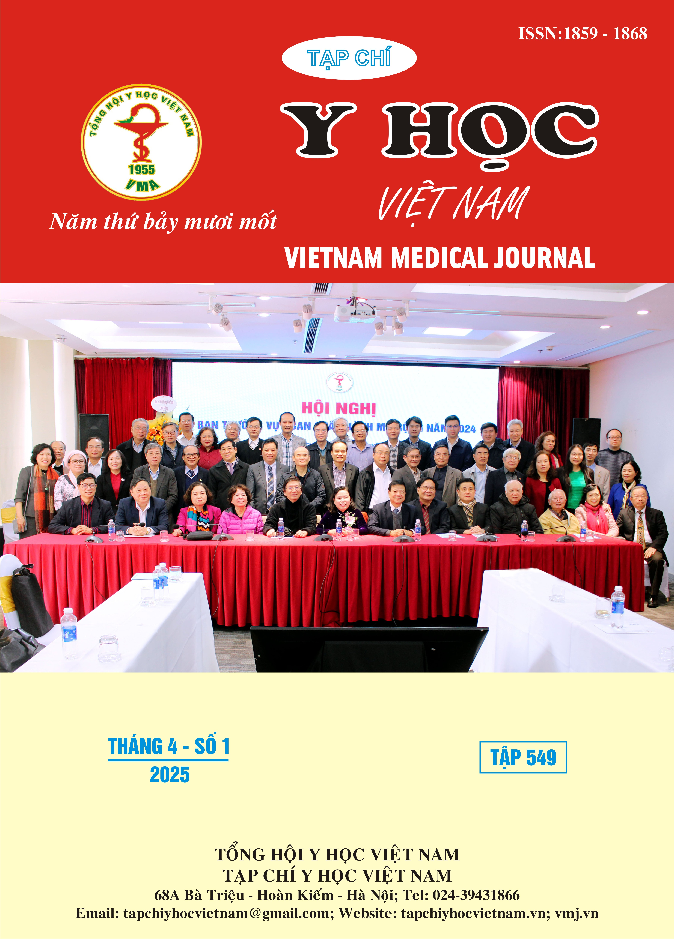SỬ DỤNG VẠT NIÊM MẠC XOANG BƯỚM TÁI TẠO NỀN SỌ TRONG PHẪU THUẬT NỘI SOI QUA ĐƯỜNG MŨI ĐIỀU TRỊ CÁC BỆNH LÝ VÙNG HỐ YÊN
Nội dung chính của bài viết
Tóm tắt
Mục tiêu: Dùng vạt niêm mạc xoang bướm tái tạo nền sọ trong phẫu thuật nội soi qua đường mũi điều trị các bệnh lý vùng hố yên, đánh giá hiệu quả và tỉ lệ các biến chứng Đối tượng và phương pháp nghiên cứu: 57 bệnh nhân có tổn thương vùng hố tuyến yên được phẫu thuật nội soi qua mũi, sử dụng vạt niêm mạc xoang bướm kèm hoặc không kèm phương pháp khác để tái tạo nền sọ Kết quả: Tuổi trung bình 51,8 ± 13,5, nam 26 (45,6%) nữ 31 (54,4%). Mô bệnh học hay gặp nhất là u tuyến yên 36 ca (63,2%), nang Rathke 15 ca (26,3%), tổn thương viêm mạn tính 5 ca (8,8%) u nang biểu bì 1 ca (1,7%). Áp dụng thang điểm Kelly có 44 ca độ 0 (77,2%), độ I có 9 ca (15,8%), độ II có 3 ca (5,3%), độ III có 1 ca (1,7%). Ngay sau mổ có 11 ca chảy dịch mũi rỉ rả (19,6%), có 1 ca chảy dịch não tủy phải phẫu thuật lần 2 để vá rò (1,7%), triệu chứng tại chỗ rất ít gặp Kết luận: Dùng vạt niêm mạc xoang bướm để tái tạo nền sọ có những ưu điểm như: linh hoạt, dễ sử dụng, khôi phục lại đặc điểm giải phẫu, thúc đẩy quá trình tái tạo niêm mạc, giảm các biến chứng tại chỗ. Vạt niêm mạc xoang bướm nên được chuẩn bị và sử dụng ở bất kỳ ca nào có thể, và nên được xem như một phương pháp tái tạo nền sọ riêng biệt hoặc bổ trợ cho các phương pháp khác.
Chi tiết bài viết
Tài liệu tham khảo
2. Jae-Hyun Park M.D., Jai Ho Choi M.D., et al: Modified Graded Repair of Cerebrospinal Fluid Leaks in Endoscopic Endonasal Transsphenoidal Surgery. J Korean Neurosurg Soc (2015) 58: 36-42.
3. Mendel Castle‑Kirszbaum, Yi Yuen Wang, et al: Closure of skull base defects after endoscopic endonasal transsphenoidal surgery: the role of the local sphenoid mucosal flap for low flow leaks. Neurosurgical Review (2022) 45: 429–437
4. Kosaku Amano, Tomokatsu Hori, et al: Repair and prevention of cerebrospinal fluid leakage in transsphenoidal surgery: a sphenoid sinus mucosa technique. Neurosurgical Review (2015) 39: 123-31.
5. Tae-Mi Yoon, Sang-Chul Lim, et al: Utility of sphenoid mucosal flaps in transnasal transsphenoidal surgery. Acta Oto-Laryngologica (2008) 128: 785-789.
6. Erden Goljo, Eliezer Kinberg, et al: Reconstruction of a skull base defect after endoscopic endonasal resection of a pituitary adenoma: Sphenoid mucosal flaps. American Journal of Otolaryngology (March–April 2018) 39 (2): 253-256.
7. Gondim JA, Almeida JP, Albuquerque LA, et al: Endoscopic endonasal approach for pituitary adenoma: surgical complications in 301 patients. Pituitary (Jun 2011) 14(2):174–83
8. Kassam AB, Prevedello DM, et al: Endoscopic endonasal skull base surgery: analysis of complications in the authors' initial 800 patients. J Neurosurg (2011) 114(6):1544–68
9. Andrew Conger M.D., Fan Zhao M.D. et al: Evolution of the graded repair of CSF leaks and skull base defects in endonasal endoscopic tumor surgery: trends in repair failure and meningitis rates in 509 patients. J Neurosurg (Mar 2019) 130(3):861-875


